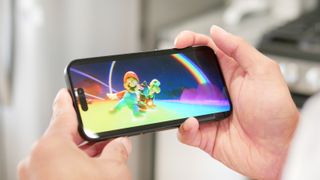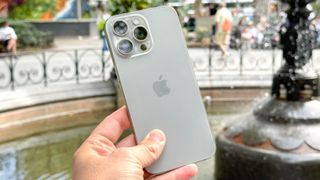All eyes may be on the iPhone 16, which is set to launch this fall and could mark the beginning of a new era for Apple iPhones, with Apple’s AI enabling a host of new AI experiences. While the iPhone 16 Pro and iPhone 16 Pro Max are expected to get the most exposure in the lineup, you may want to hold off on upgrading to either model given the details that have started to emerge about the iPhone 17.
There are several reasons why you should ditch the iPhone 16 in favor of the iPhone 17, as early rumors point to massive upgrades for the 2025 phones that could redefine the series. Year-over-year upgrades like brighter displays, better cameras, and longer battery life are all expected for the iPhone 17, but we could end up seeing another generation-defining model — much like the iPhone X turbocharged Apple’s phone lineup in every way imaginable in 2017.
@tomsguide ♬ original sound – Tom’s Guide
We’ve rounded up all the iPhone 17 rumors we know about, so you can understand what’s at stake — and how they’re all valid reasons to wait another year to upgrade.
120Hz refresh rate with all models

One of the biggest criticisms of the non-Pro versions of the iPhone is how Apple continually molds them with outdated 60Hz refresh rates. When cheaper Android phones like the Samsung Galaxy A35 and Google Pixel 8a both have 120Hz display refresh rates, it’s almost unbelievable that the iPhone 16 and 16 Plus are still supposedly stuck at 60Hz.
Well, Apple is expected to finally make 120Hz the standard for all of its 2025 iPhones, including the base iPhone 17, which could greatly benefit from a 120Hz ProMotion display. Such a move would be a long time coming, but it’s certainly a marked upgrade for the iPhone 17 with smoother animations and responses with its display. This would inherently make gaming much more satisfying thanks to smoother frame rates.
48MP sensor on all three cameras of the iPhone 17 Pro Max

Cameras are always the most important features people consider when buying a new phone, and it looks like Apple won’t disappoint anyone with the three cameras on its Pro models. The iPhone 16 Pro Max is expected to feature a longer zoom with its telephoto lens and a larger 1/1.4-inch sensor, but the iPhone 17 Pro Max’s cameras might be worth the wait.
That’s because both devices are rumored to feature 48MP sensors across their three cameras. This is a splendid upgrade for their ultra-wide and telephoto cameras, which could make them much more valuable when combined with new image processing algorithms and pixel binning technology. Paired with another rumor about a variable aperture lens to give photographers even more control over the camera, there’s undoubtedly a lot going on with the iPhone 17 Pro Max.
The thinnest iPhone model yet

We’ve been hearing rumors of an iPhone 16 Ultra model for a while now, but it’s still unclear whether or not that will come to fruition this fall, when the iPhone 16 lineup is expected to be announced. While an Ultra seems unlikely at this point, it’s possible that the device could emerge next year under an entirely different name, the iPhone 17 Slim.
Rumors have it that Apple could be ditching the iPhone 17 Plus model and instead opting to add the iPhone 17 Slim to its lineup. Not only would it be the thinnest iPhone yet, featuring an all-new design in contrast to the current design language, but it could also be the most expensive yet, with a whopping $1,299 price tag, more than the $1,199 Apple currently charges for its Pro Max model.
Bloomberg’s Mark Gurman claims that Apple’s plan is to create “a new class of Apple devices that are expected to be the thinnest and lightest products in the entire technology industry.” That higher cost would be backed by an A19 chip, 8GB of RAM, an aluminum chassis, and a dual rear camera system.
Faster A19 Pro chips based on 2nm manufacturing process

Speaking of processing power, the iPhone 17 would naturally have a head start in terms of performance, mainly because the new models would be powered by faster A19 chips, compared to the A18 processors expected with the iPhone 16.
The main reason for this performance improvement is that the A19 Pro chip, especially those that power the iPhone 17 Pro models, could be manufactured using a 2nm manufacturing process. This would result in a higher transistor density, which would ultimately improve its processing performance.
Better energy efficiency

Improved processing performance goes hand in hand with power efficiency, which could also mean bigger battery life gains for the iPhone 17 lineup. We’ve seen this for ourselves in how each new generation of iPhone with newer chips frequently outperforms its predecessors in our battery benchmark tests.
If that’s not enough to convince you to postpone buying the iPhone 16, it’s believed that Apple will develop its own in-house batteries with the iPhone 17. In doing so, the company could further optimize the power efficiency of its iPhone 17 lineup.
24MP selfie cameras

While we’ve seen worse selfie cameras than current iPhones, the iPhone 17 could get a nice upgrade in the form of 24MP front-facing cameras according to longtime analyst Ming-Chi Kuo.
Apple is expected to continue using the same 12MP selfie cameras for the iPhone 16, including the Pro models. Given that the 12MP camera has been in place since the iPhone 11, this would be an added incentive to wait for the iPhone 17.
12GB RAM in Pro models
The iPhone 17 Pro and iPhone 17 Pro Max could also get a major RAM overhaul, which could be bumped up to 12GB. The iPhone 16 Pro and iPhone 16 Pro Max, on the other hand, are expected to retain the same 8GB of RAM as before.
This RAM upgrade could allow the iPhone 17 Pro and 17 Pro Max to not only better handle AI-assisted features, but it could also keep apps in memory for longer, which is helpful if you’re constantly multitasking.